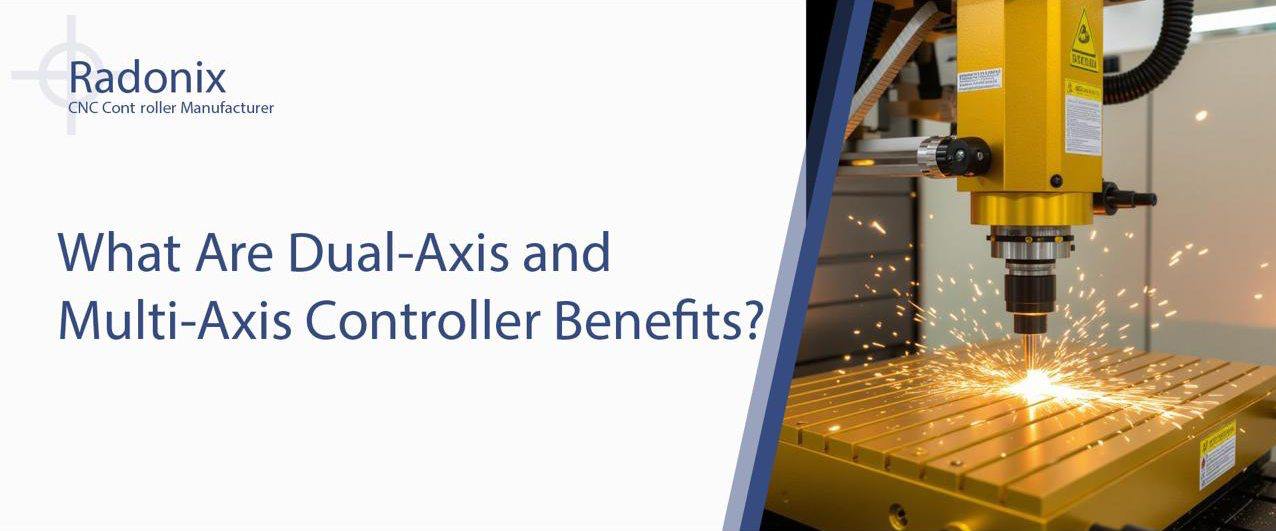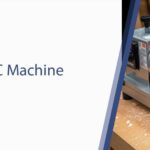Radonix offers advanced solutions like the PC-Smart (fifth-generation) and PC-Pro LAN (fourth-generation) series, supporting up to 6 axes for precise, multi-faceted operations.
In September 2025, with our sixth-generation open-source, cloud-based controllers now available, understanding the benefits of dual-axis and multi-axis controllers is crucial for optimizing efficiency, precision, and scalability.
Whether you’re an SME entering CNC or a large manufacturer tackling complex robotics, these controllers transform raw ideas into high-quality products.
If you’re wondering what are dual-axis and multi-axis controller benefits, this comprehensive guide cuts through the noise. We’ll define each, highlight their advantages with real-world data, compare them, and showcase how Radonix integrates them for superior performance.
By choosing the right controller, you can reduce production costs by 30-40%, minimize errors, and stay ahead in a market where multi-axis machining is projected to grow at 7.5% CAGR through 2030. Let’s explore the benefits and why Radonix leads the way.
Defining Dual-Axis Controllers: Simplicity and Accessibility
A dual-axis controller manages two linear or rotary axes simultaneously, typically X and Y for basic operations like 2D profiling or simple turning. In CNC systems, it interprets G-code to coordinate movements, often used in entry-level machines for tasks such as engraving or basic milling.
Radonix’s PC-Smart series includes dual-axis configurations as a starting point, with high-pulse outputs (up to 500,000 pulses/second) ensuring smooth performance even in compact setups.
Key Benefits of Dual-Axis Controllers
Dual-axis controllers shine in straightforward applications, offering affordability and ease of use without overwhelming complexity.
- Cost-Effectiveness: These controllers are budget-friendly, making them ideal for startups or hobbyists. According to manufacturing insights, they can be 30-50% less expensive than multi-axis alternatives, reducing entry barriers for SMEs. Radonix’s entry-level models start under $300, delivering reliable control for 2-axis routers in woodworking.
- Simplicity and Quick Setup: With fewer axes, programming and calibration are faster. Users report 20-30% shorter setup times compared to higher-axis systems, minimizing downtime in low-volume production. Our Cam-Pro software simplifies G-code generation for dual-axis tasks, like cutting flat panels.
- Energy Efficiency: Operating fewer motors means lower power consumption—up to 15% savings in operational costs. This aligns with 2025’s sustainability trends, where energy-efficient CNC is a priority.
- Reliability for Basic Tasks: Ideal for repetitive 2D work, they reduce mechanical wear. In jewelry engraving, dual-axis controllers maintain ±0.01mm accuracy with minimal maintenance.
While limited to planar operations, dual-axis controllers provide a solid foundation, especially when integrated with Radonix’s Ethernet connectivity for remote monitoring.
Exploring Multi-Axis Controllers: Powering Complex Precision
Multi-axis controllers handle three or more axes (e.g., X, Y, Z, plus rotary A, B, C), enabling 3D and beyond machining. They support simultaneous movements for intricate paths, essential in advanced manufacturing.
Radonix’s PC-Pro LAN and sixth-gen controllers excel here, managing up to 6 axes with AI-optimized algorithms for predictive control, launching in Q1 2025.
Top Benefits of Multi-Axis Controllers
Multi-axis systems unlock capabilities far beyond dual-axis, driving innovation in 2025’s smart factories.
- Enhanced Precision and Accuracy: By rotating the workpiece or tool in multiple directions, these controllers achieve tolerances as tight as ±0.005mm. This is critical for complex geometries, reducing errors by 40-50% in parts like turbine blades or robotic joints. Radonix’s closed-loop feedback minimizes backlash, ensuring superior surface finishes.
- Complex Part Geometries: Handle undercuts, curves, and 3D contours without repositioning. In robotics, multi-axis machining fabricates intricate arms with 35% better structural integrity. Our XYZ Plasma Pipe interface uses 5-6 axes for 360° cuts, impossible with dual setups.
- Fewer Setups and Reduced Downtime: Single-setup machining cuts handling time by 50-70%, boosting throughput. Radonix users in metal processing report 40% faster cycles, with automated tool changes via Cam-Pro.
- Improved Production Speed and Efficiency: Optimized paths increase material removal rates by 20-30%, shortening lead times. In 2025, AI integration in our seventh-gen previews (2026) predicts disturbances, enhancing speed without compromising quality.
- Better Surface Quality: Continuous tool engagement avoids marks, improving finishes by 25%. For aerospace parts, this means less post-processing.
- Versatility Across Industries: From woodworking (3-4 axes for furniture) to robotics (5-6 axes for assemblies), multi-axis controllers adapt seamlessly. Radonix’s open-source design allows customizations, supporting hybrid manufacturing trends.
- Cost Savings in the Long Run: Though initial investment is higher, ROI comes from reduced waste (up to 25%) and scalability. SMEs using Radonix report 30% lower operational costs over time.
These benefits position multi-axis controllers as the future, especially with 2025’s emphasis on automation and precision.
Dual-Axis vs. Multi-Axis Controllers: A Head-to-Head Comparison
Choosing between dual and multi-axis depends on your needs. Here’s a breakdown:
| Aspect | Dual-Axis Benefits | Multi-Axis Benefits | Best For |
| Complexity | Handles 2D tasks efficiently | Excels in 3D/complex shapes | Multi for advanced; dual for basics |
| Cost | Lower upfront (30-50% cheaper) | Higher initial, but 40% ROI boost | Dual for budgets; multi for value |
| Setup Time | Quick (20% faster) | Fewer repositions (50% less downtime) | Dual for simple; multi for production |
| Precision | Good for flat work (±0.01mm) | Superior (±0.005mm) | Multi for tolerances |
| Applications | Engraving, basic cutting | Robotics, aerospace | Dual entry-level; multi pro |
| Efficiency | Energy-saving (15%) | Speed gains (30%) | Multi for scale |
Dual-axis suits simple, cost-sensitive ops, while multi-axis drives innovation. Radonix bridges both with modular upgrades.
Radonix’s Dual and Multi-Axis Solutions: Tailored for Excellence
At Radonix, our controllers evolve with your needs. The PC-Smart series starts with dual-axis for affordability, scaling to 6 axes for multi-faceted tasks. Our sixth-gen cloud models integrate IoT for remote multi-axis monitoring, reducing failures by 35%. Cam-Pro software optimizes paths for any axis count, with 2025 AI features predicting wear.
For dual-axis: Ideal in our XYZ Router for 2D woodworking.
For multi-axis: PC-Pro LAN powers 5-axis plasma cutting, with 10-year warranties ensuring reliability.
Applications: Where These Controllers Shine
- Woodworking: Dual for flat engravings; multi for 3D carvings.
- Metal Processing: Multi for helical gears in robotics.
- Glass/Stone: Multi for curved edges.
- Robotics: 5-6 axes for precise joints.
Case Study: An Iranian manufacturer using Radonix multi-axis reduced cycle times by 45% on robotic parts.
2025 Trends: The Future of Axis Controllers
In 2025, multi-axis dominates with AI integration (50% adoption rise) and hybrid systems. Dual remains niche for eco-friendly, low-power apps. Radonix’s seventh-gen will feature quantum-inspired tuning for ultra-precision.
Step-by-Step Guide: Implementing Dual or Multi-Axis Controllers with Radonix
- Assess Needs: Evaluate complexity—dual for 2D, multi for 3D.
- Select Hardware: Choose PC-Smart for dual; PC-Pro for multi.
- Install Software: Use Cam-Pro for path generation.
- Calibrate: Tune PID for accuracy.
- Test and Optimize: Run simulations; monitor via cloud.
- Scale: Upgrade axes as needed.
Avoid pitfalls like under-calibration; Radonix support ensures success.
Conclusion
Dual-axis controllers offer affordability and simplicity, while multi-axis controllers deliver precision, efficiency, and versatility for complex tasks. In 2025, Radonix empowers both, from entry-level to advanced manufacturing.
Contact Us:
- E-Mail: info@radonix.com
- Phone: +90 (553) 920 5500








